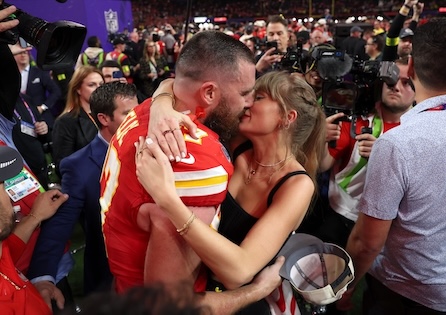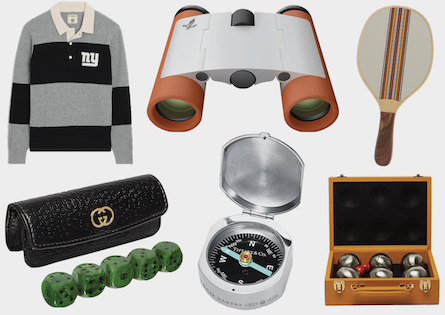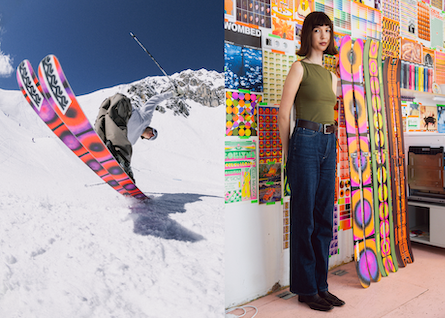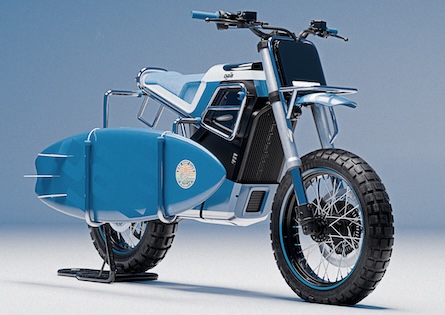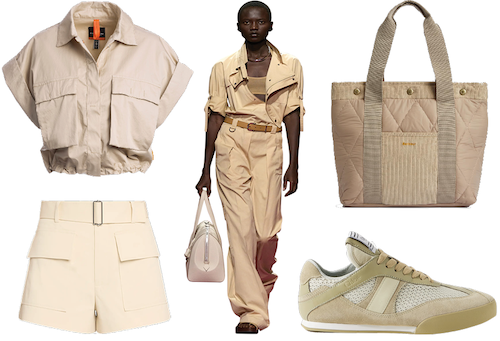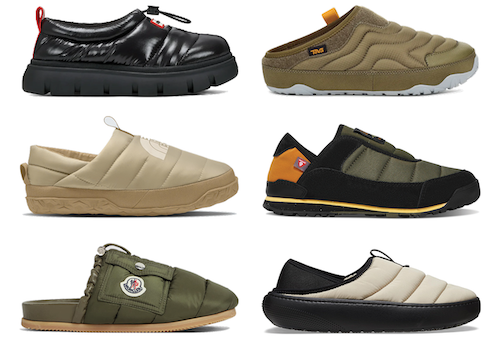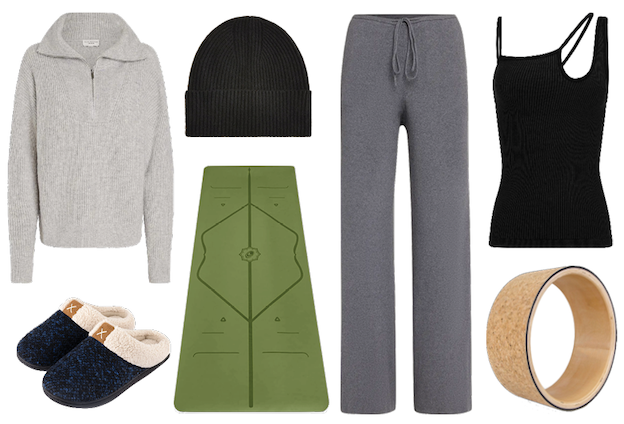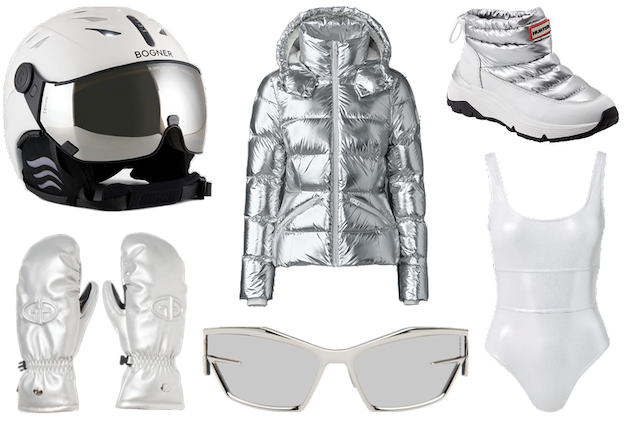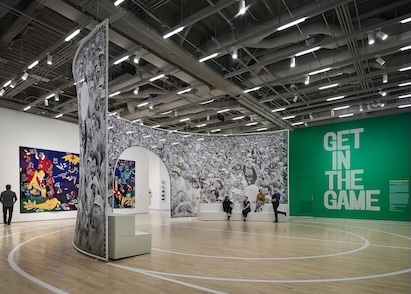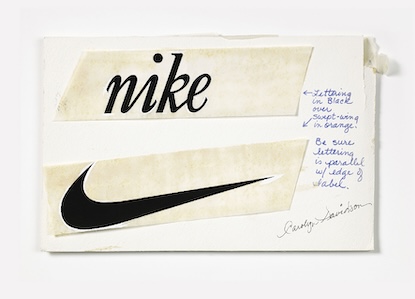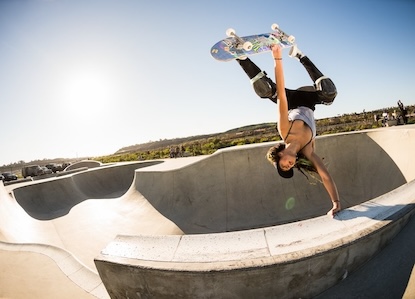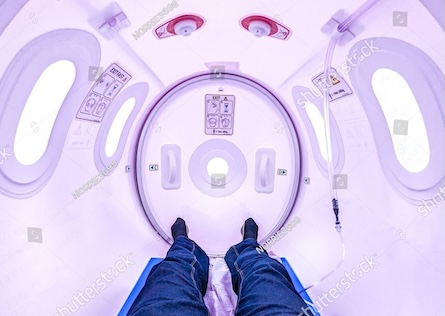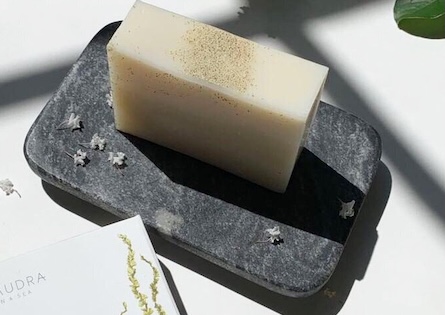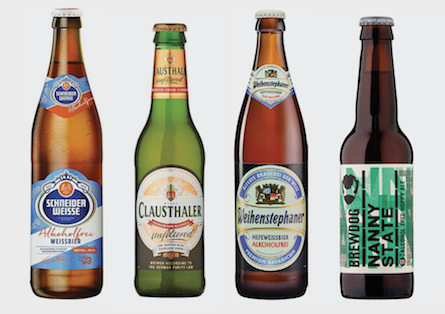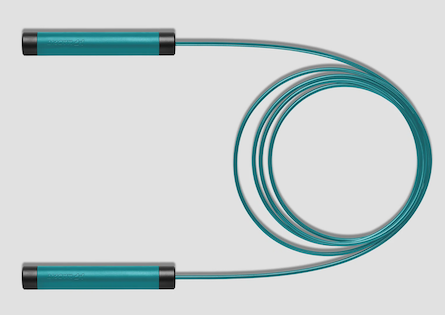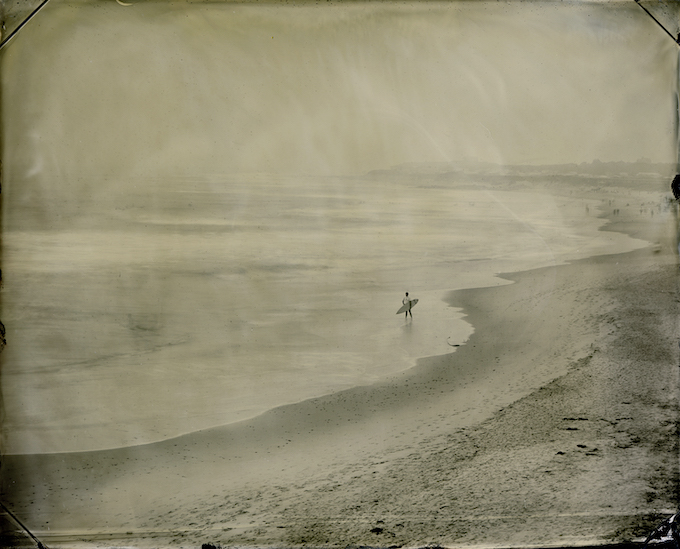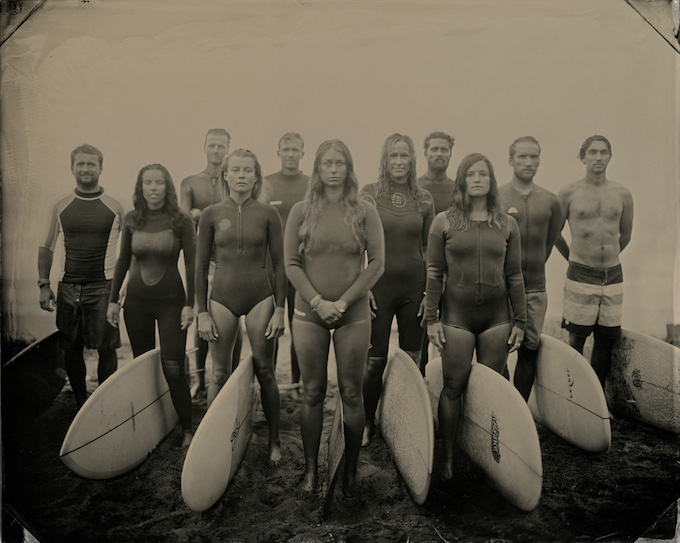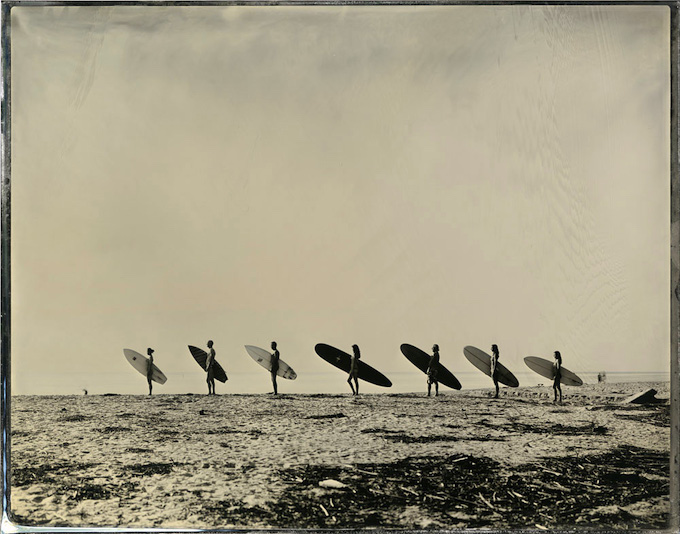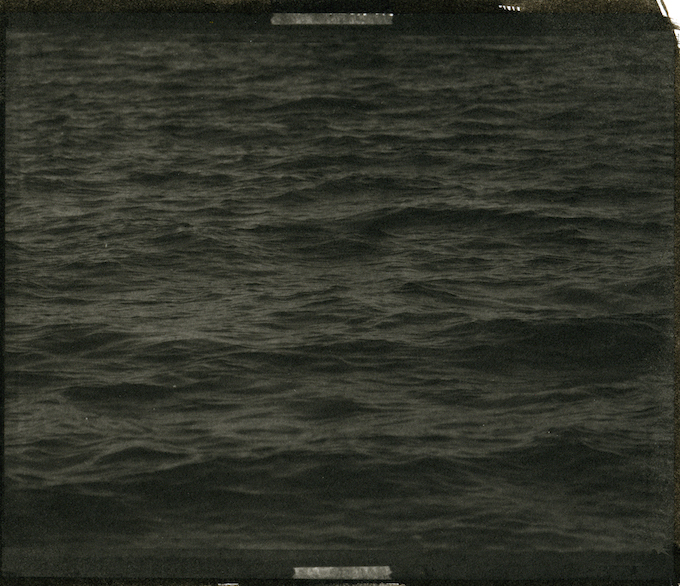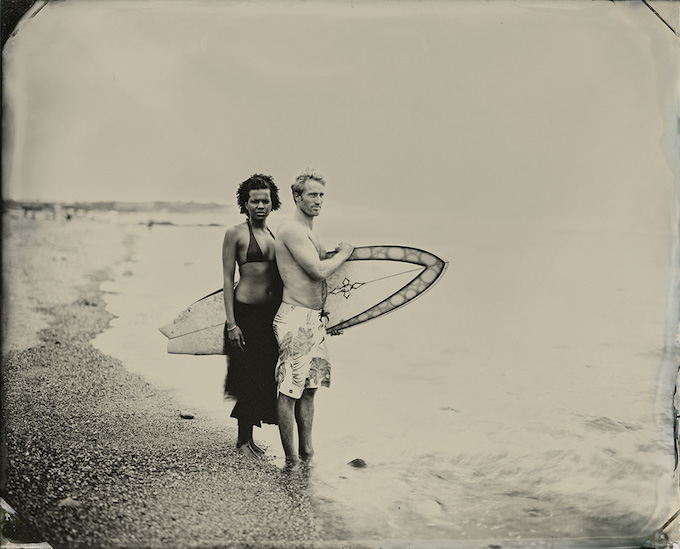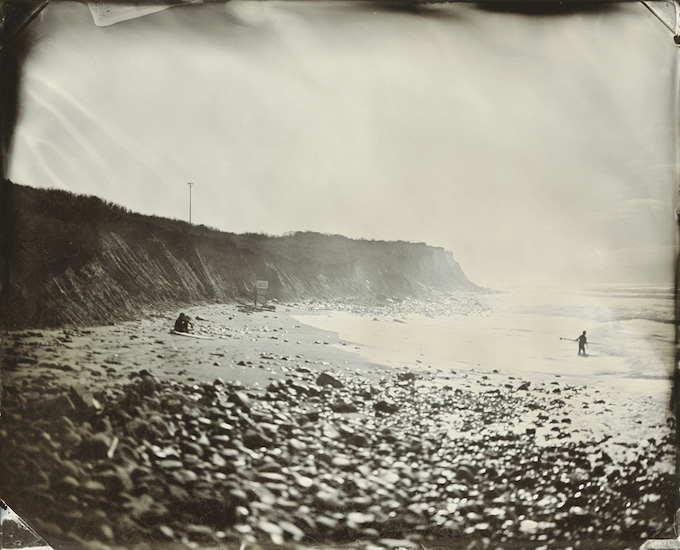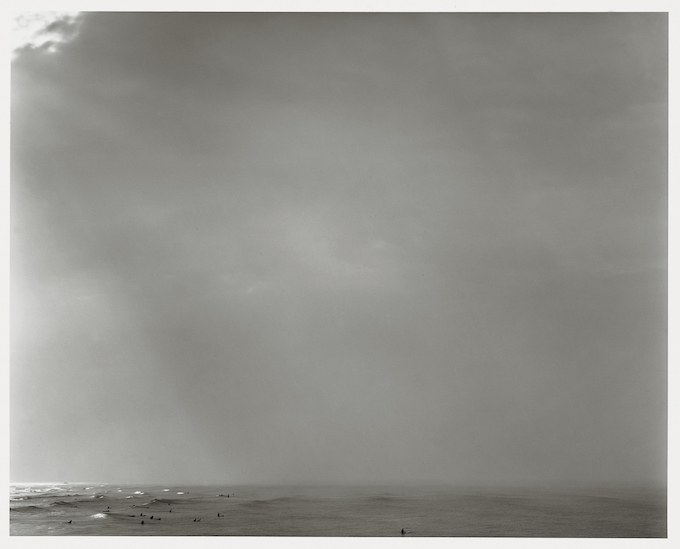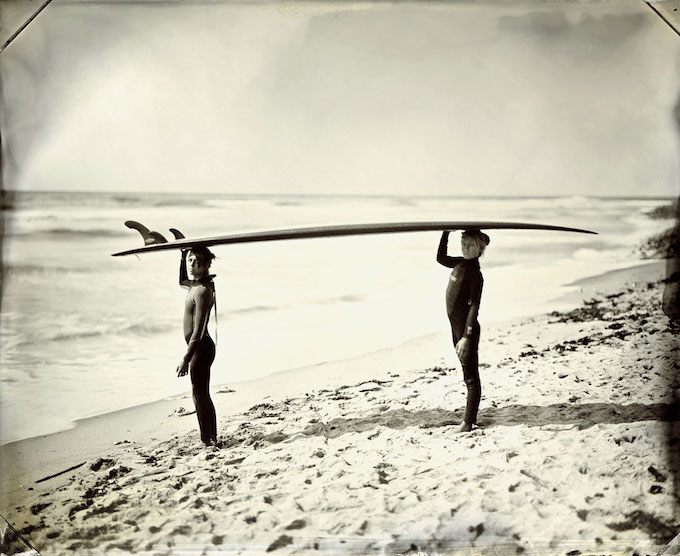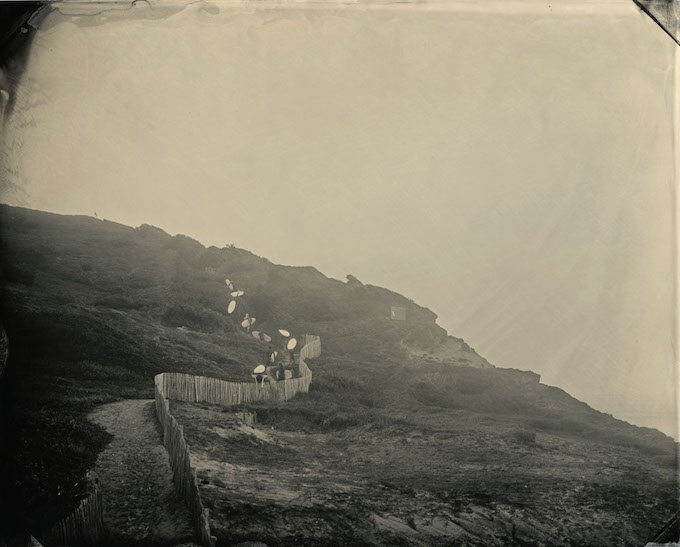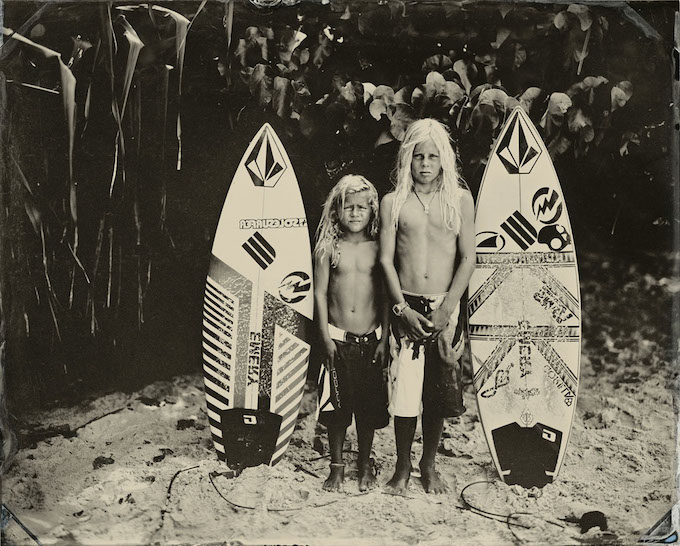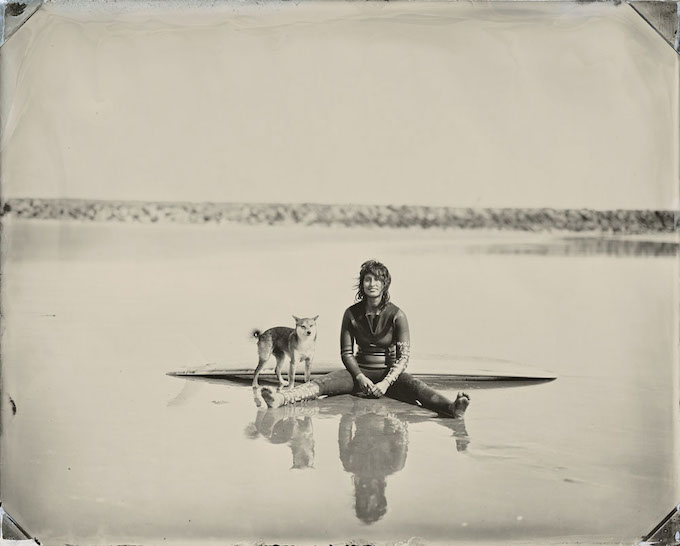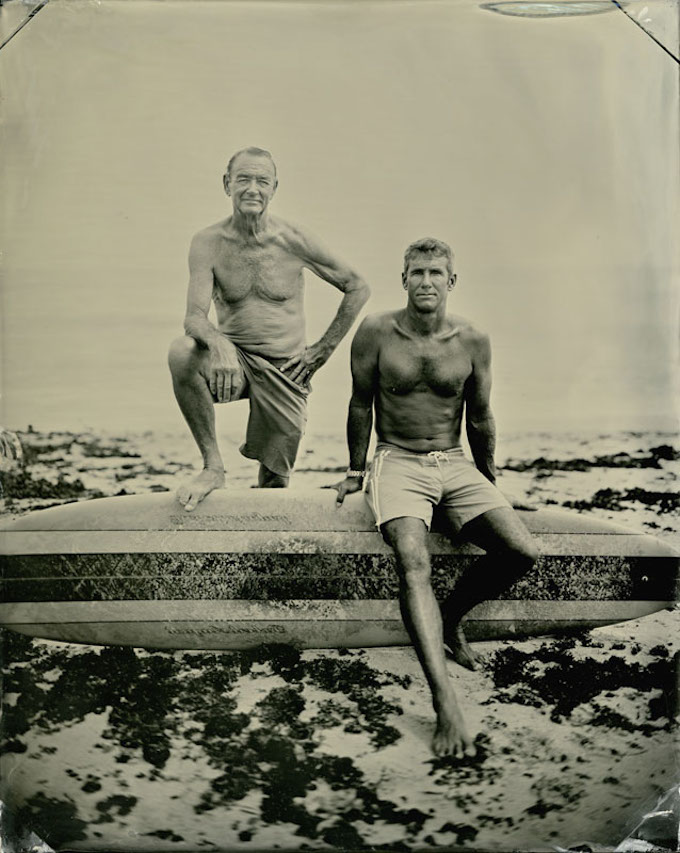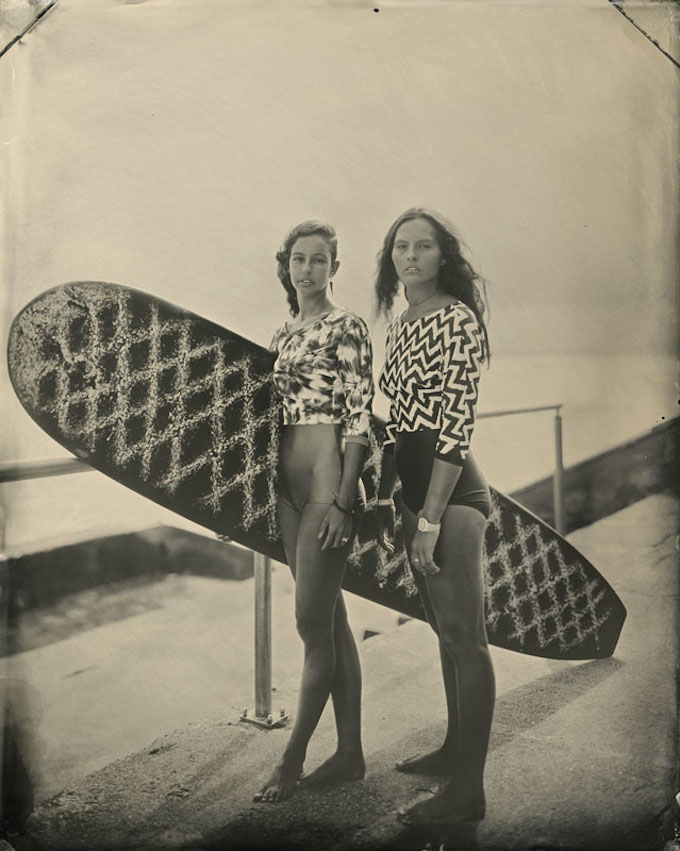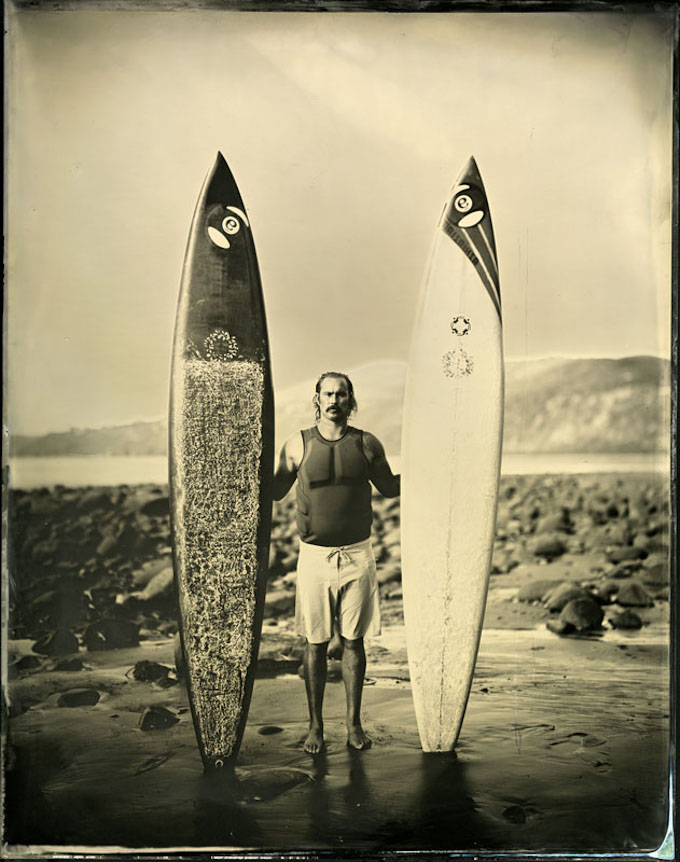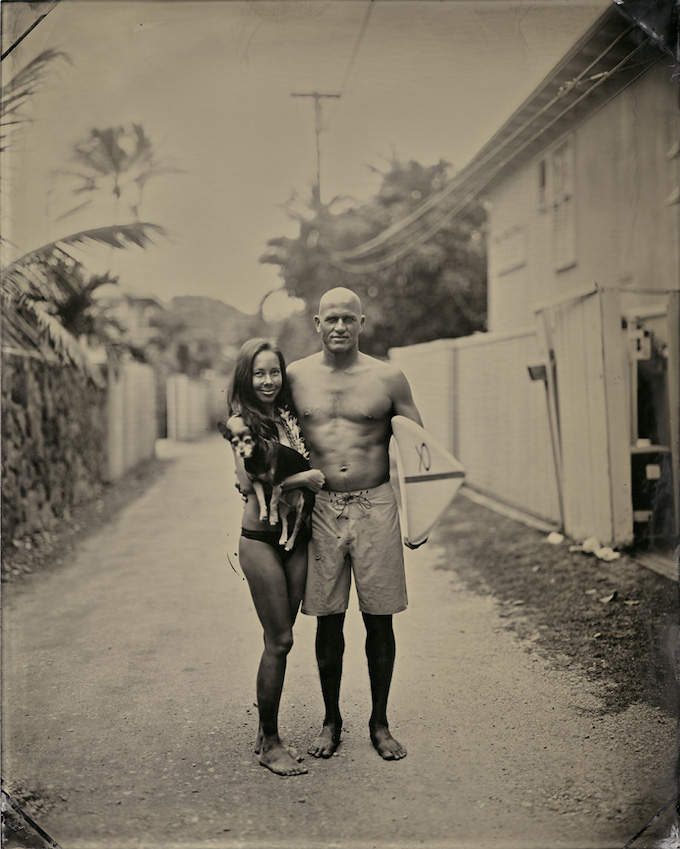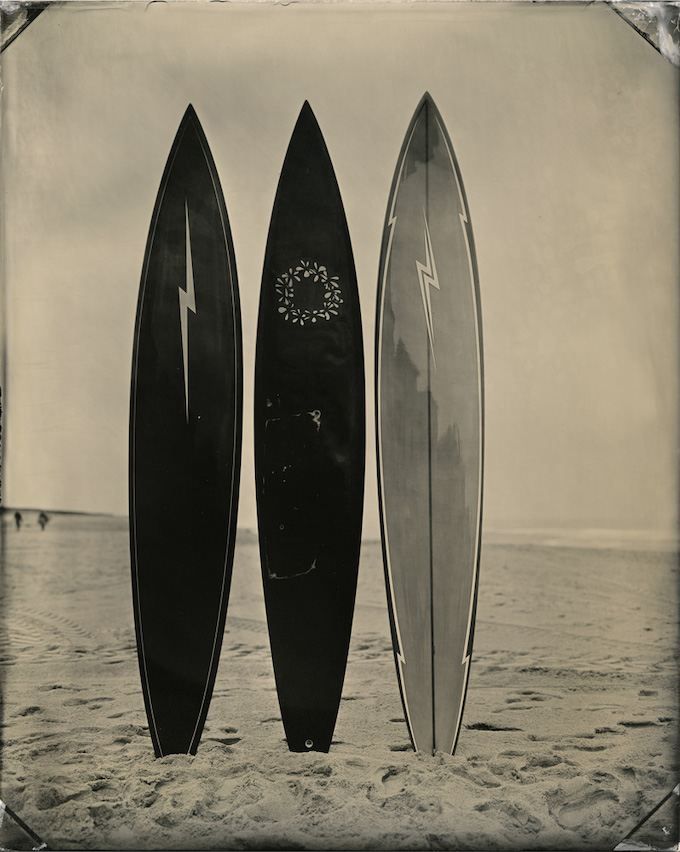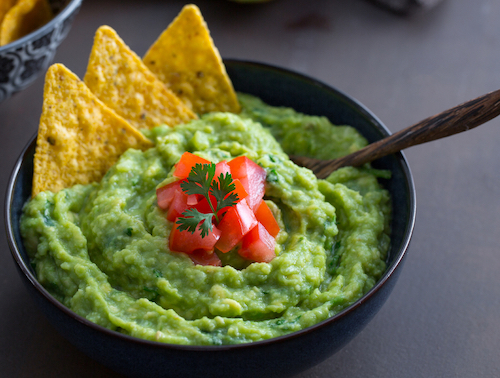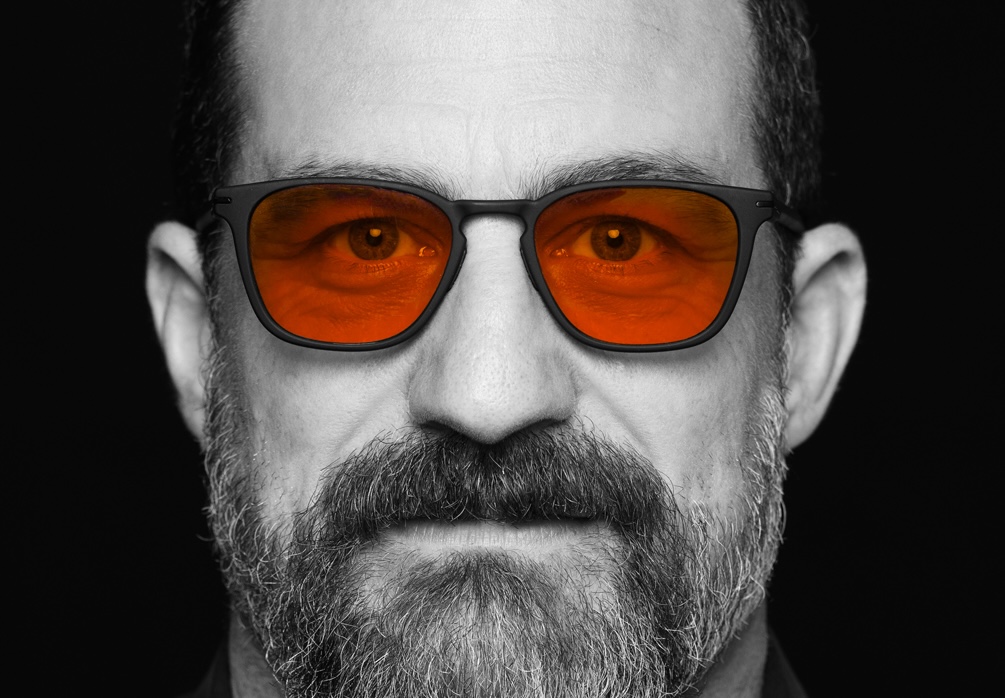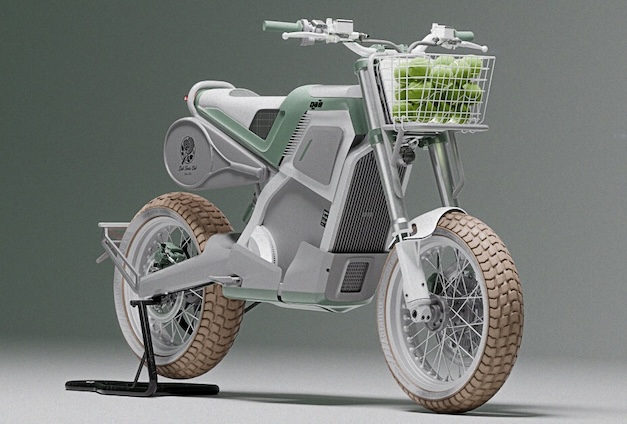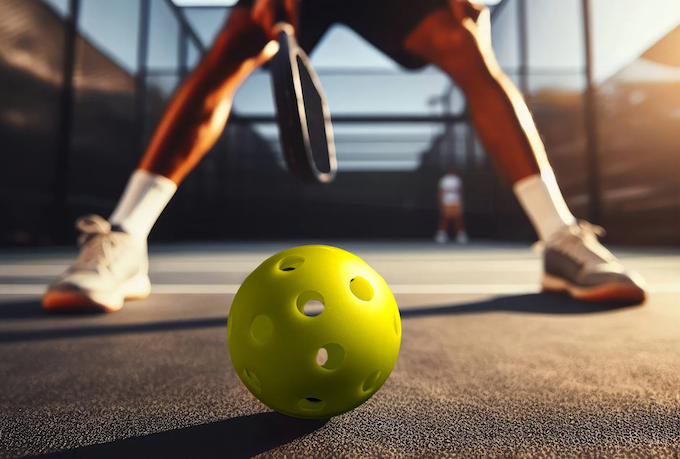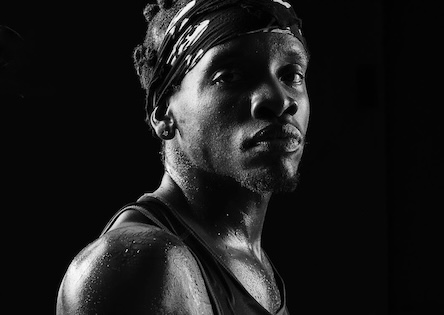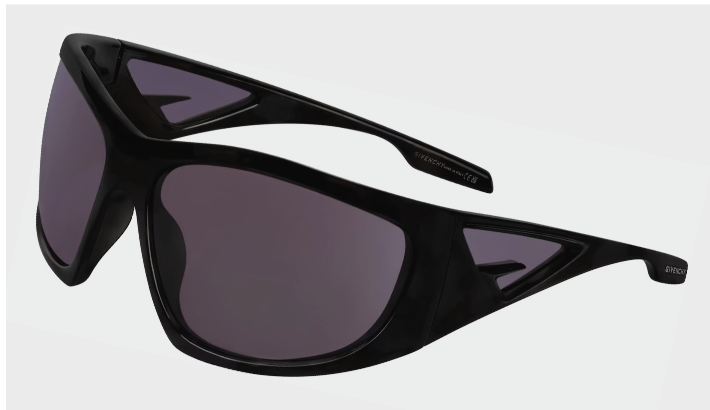FIRST SURFER TINTYPE, LONE SURFER, 8×10, MONTAUK, NEW YORK 2015; BIDART GROUP, 8×10, BIDART, FRANCE; THE FUTURE, 11×14, 2015 SANTA BARBARA, CA.
At The Art Show last month at the Park Avenue Armory in NYC, the work of Joni Sternbach was on view at the Von Lintel Gallery booth. A write up of the show in The New York Times featured a triptych her tintype photographs titled The Women and The Waves. As a fan of surf photography, I hustled over to see the work, and to my delight Sternbach was there as well.
Surfland is an on-going series of tintype portraits of surfers that represent a unique blending of subject matter and photographic technique. Working with a large-format camera, Sternbach has been photographing surfers around the world since 2006 using this antiquated process. Ironically, Sternbach had no intention of photographing surfers – nor does she surf – until they paddled into her frame one day. The project began as an ocean series. Waving them off, she never expected they would become the subject.
Popular in the mid-late 1800’s, a tintype is actually an underexposed negative created on a chemically coated, blackened metal plate in what is called the wet-plate collodion process. When the plate is exposed to light through the camera, an image develops with transparent areas appearing black because of the background. The overall darkness of the image gives the aura of a vintage photograph.
Like a polaroid, the images must be developed on the spot, and all aspects of the process take place out in the open for all to see. As such, Sternbach’s photographs involve a piece of performance. The raw quality and immediacy of collodion, she says, suits her subject matter, “giving it a distinctive appearance and echoing important traditions of nineteenth-century anthropological photography.”
TOP: FROM THE OCEAN DETAILS SERIES, MONTAUK, 1999; JANINE+GRAHAM, 8×10, MONTAUK, NY 2007; TURTLE COVE, 8×10, MONTAUK, NY 2006
Surf photography has a rich history of iconic imagery. Photographers like Don James in the 1930’s and 40’s, Ron Church in the 1950’s and 60’s, Leroy Grannis in the 1960’s and 70’s, and Jeff Divine in 1970’s and 80’s (just to name a few of my favorites), and many others up to this present day have long immortalized surf culture and its famed wave riders in their timeless photographs. Sternbach’s images have that same quality. Her photographs of current surfers, both the famous and everyday wave riders, have a historical quality and look as though they were created in the mid-1800’s when surfing first came to America.
I chatted with Sternbach at the show and in greater depth a few days later about her work, the medium, and the evolution of the Surfland:
STYLE OF SPORT: As someone who does not surf, what drew you to surfers?
JONI STERNBACH: I started out by photographing the ocean. I have a place in Long Island and would drive out to Montauk. I’d stand at the top of the bluff with my 8 x 10 camera and aim it down at the ocean during high tide because that’s when the ocean was the closest to where I was. I could get this little narrow view without the horizon. I wanted the perspective of just the ocean surface to see what that would look like in a photograph.
FROM THE SEA/SKY SERIES, 40 x 50, 2002
SOS: When did the surfers literally enter the picture?
JS: I started the Ocean Details series in the winter. The following spring I was standing on the bluff and it was foggy. I love to photograph in the fog and suddenly these surfers appeared in my picture. I was like, ‘Who are these people and what are they doing in my photograph?’ I’m photographing this narrow little piece of the ocean and there’s people? I’m trying to get away from people. I whistled out to the ocean and they looked up. I waved at them to get away, but they probably thought I wanted to photograph them. This was my first interaction with surfers.
But when I developed the pictures it was like ‘Oh my god!’ It looked like a Turner painting (above). The important part of the photograph became the people — not so much because they were surfers, but because they created this ambiguity as to whether they were human or animal. I felt in that moment that I had bonded with all these people in the water.
SOS: But you’re still way up on the bluff. How did you end up connecting with them?
One day my husband I suggested I go back to the same bluff with my wet plate gear. I asked why. “I don’t know”, he said, “go see how it looks.” So my assistant and I went out. There was a guy on the bluff. He saw my camera and asked if I was a photographer. I told him yes and asked if he’d go down to pose for a picture. “Oh I don’t like to be in front of the camera,” he said. I told him he’d be tiny, gesturing with my thumb and finger, and he did.
MINNIE+LULU, 8×10, MONTAUK, NEW YORK 2006; LE RESSAC, 8×10, BIDART, FRANCE 2015; RASMUS+KYUSS, 8×10, BYRON BAY, NSW, AUSTRALIA, 2011; KASSIA, 8×10, OCEANSIDE, CALIFORNIA 2010
I coated my plate, loaded it in the camera, and framed the photograph. He went down and put on a white rash guard, which made him sort of pop in the frame. I told him to get into position and hold still until I gave him a thumbs up. He was standing with his board under his arm facing me. I took the picture and processed it there immediately. It was like ‘Wow, this is a fucking fantastic photograph!’ (Lone Surfer, top). We knew there was a project there.
SOS: Surfers have such a particular body language that naturally comes with the way they stand, hold their boards, and pose with them in the sand and water. The purity and authenticity makes for such beautiful photographs. Tell me how you ended up photographing all these other surfers.
JS: The following week I came down off the bluffs and went onto the beach at Ditch Plains. I saw a guy who had his photography gear and umbrella. I set up my camera not too far away. I just wanted to position myself there and see what happens because I was very intimidated about approaching people to make their photograph. Remember, I am landscape photographer. I had been shooting on the bluffs for a long time and my people chops were rusty.
The guy came over and asked if that was an old camera. I told him about the camera and the tintype process, that it was from the 1850’s, and how you can develop the photograph on the spot. It takes about 15 minutes start to finish but you can see your picture right after it’s developed. “Yeah, just like my digital camera”, he replied. I asked if he was a surfer and if he would pose for me. He said sure. We went out to the water and I asked him to stand a certain way. He told me surfers don’t pose like that. I asked him to show me how a surfer holds a board. He just put the board on top of his head and it was a gorgeous photograph.
ROBERT+WINGNUT, 8×10, MONTAUK, NEW YORK 2014; LAURE+CHLOE, 8×10, BIARRITZ, FRANCE 2015; DRAKE, 11×14, SANTA BARBARA, CALIFORNIA 2015
SOS: Surfing gives a photographer so much to work with and an opportunity to create these timeless images. You capture that so authentically.
JS: I learned that because I didn’t know anything about surfing, I really needed my subjects to guide me, and they were happy to. I kept coming back, and coming back, trying to get people familiar with me. There was the whole surfing element and then also the photography element. I was just learning this process as well. I really didn’t know exactly what I was doing but I learned along the way. When winter came I decided to continue the project in California. That then became my go to every winter. It became a very seasonal way of working. Australia, France, Uruguay… I finally went to Hawaii in 2017.
SOS: Surfing is a seasonal sport – chasing the waves in the search for The Endless Summer. You have to follow that as a photographer as well. Tell me about The New York Times piece. Did you know your work was going to be included?
JS: It was a total surprise. I couldn’t believe they picked it up and published one of my photographs! I made the triptych they published for the film, The Women and the Waves 2, by Heather Hudson.
SOS: Well the work is beautiful, and although I was planning on going to The Art Show anyway, the article was added incentive. And what a great surprise you were at the booth that day! Great to have the opportunity to meet and talk to you about your work. Thanks Joni!
